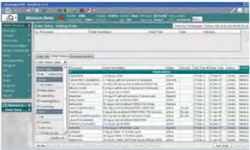- Show Menu
- Contact Us
- FAQs
- Reader Service
- Survey Data
- Survey Winners
- Testimonials
- Upcoming Events
- Webinars
- White Papers
CPOE Order Set Design
 Standardized order sets within computerized physician order entry (CPOE) systems offer hospitals several benefits, not the least of which is the availability of legible, complete, and structured physician orders to users throughout the facility. Order sets also provide physicians with all relevant orders and reduce their reliance on memory — a standard patient safety principal.
Standardized order sets within computerized physician order entry (CPOE) systems offer hospitals several benefits, not the least of which is the availability of legible, complete, and structured physician orders to users throughout the facility. Order sets also provide physicians with all relevant orders and reduce their reliance on memory — a standard patient safety principal.
Research has shown that — no matter how you slice it — in the beginning, entering orders electronically takes longer than handwriting orders. So, by improving provider efficiency, standardized order sets can improve provider acceptance of CPOE, reduce practice variation, and encourage adherence to organizational standards of care.
The use of order sets can also decrease the risk of medication errors and adverse drug events. The inclusive nature of electronic order sets can reduce omission errors, and by defaulting to evidence-recommended doses, order sets can guide physicians in writing appropriate orders. Via Web links, order sets can also provide direct access to literature and facility protocols, integrating evidence-based information into physicians’ everyday point-of-care practices. By pushing information to physicians, electronic order sets make it easier for them to do the right thing.
“Rules of Thumb” for Order Set Design
In designing your facility’s CPOE order sets, keep the following in mind: Speed is everything; order sets must fit into the user’s workflow; and little things can make a big difference. The design of order sets should allow physicians to quickly enter orders, by offering all indication-specific orders from one menu. Involve a “clinical author” from the medical team — a physician extender, advanced practice nurse, or physician’s assistant — to inform the order set design team of physician practices and the acceptability of proposed order sets. The clinical author is the ultimate “owner” of the order set, and any changes proposed by others must be approved by the owner. Establishing clinician ownership is very important to the overall rollout.
Your hospital’s use of CPOE is likely driven by a plan to improve the quality of care and drive standardization throughout your processes. With this in mind, you may elect to prohibit physician use of personalized order sets. However, if physicians indicate they would like a particular treatment listed at the top of an order set, for instance, there is no reason not to fulfill their request, provided it does not conflict with an established core value of your organization. To further facilitate efficiency and workflow, consider linking your admission order sets with forms that allow physicians to document patient allergies and the like, without toggling through different screens in your electronic medical record. In other words, if you can make a physician’s life easier through order set design, do so.
The use of an established template can ensure consistency in the presentation of your order sets, which is particularly important in view of staff turnover. The template should include every detail of the order sentence, allowing your IT team to build comprehensive order sets. It is wise to develop a test template and build one online order set for clinicians to pilot. From their feedback, you will be able to fine tune the design, before rolling out hundreds of order sets that physicians will not want to use.
In addition, physicians may request the development of new order sets. Consider whether or not those order sets will be commonly used before embarking on the design. That said, it can be beneficial to design an elaborate, highly specialized order set, if it provides a safer means of delivering care than relying on the physician to remember the specific details necessary for safety.
Naming Order Sets for Physician Efficiency
It can be helpful to name your order sets beginning with the service type, i.e. “Cardiac Surgery/CABG Post-Op,” as it narrows the physician’s options to post-op order sets specific to that service. It is also advisable to avoid unrecognized acronyms and abbreviations in your order set names, as they can cause clinician confusion and lead to errors. Your CPOE system should also allow physicians to search for order sets using keywords. By assigning common “synonyms” to certain order set names, you can further increase physician efficiency in searching for order sets that apply to their service areas.
 Embedded Standardized Care
Embedded Standardized Care
By providing physicians with standard orders for specific medications, order sets can help drive IV to PO therapeutic substitution, antimicrobial stewardship, post-op nausea and vomiting control, and other drug-use evaluation initiatives throughout your institution. To ensure your order sets enable the delivery of standardized, high-quality care across your hospital, allow your P&T and quality committees to review and approve them before rollout. It is important that your order sets are reflective of and consistent with your organization’s improvement initiatives and standards of care. In addition, you can further drive the standardization of care by providing Web links to your facility’s online policies and protocols within your order sets.
Patient Safety Considerations
Patient safety — or the lack thereof — often comes down to minute details. With this in mind, avoid order sets that default to certain medications. Furthermore, establish limits in your CPOE system that would prevent a physician from selecting both low molecular weight and sub-Q heparin for DVT prophylaxis, for example; they should only be able to choose one — not both — from within the order set. In addition, by establishing default medication start times — i.e., 10:00AM on post-op day number one — and making them transparent to the physician, you can ensure that care is carried out properly and in a timely manner downstream. In this way, order sets again simplify the physician’s processes in providing quality care.
Off-Formulary Orders
In general, non-formulary and restricted medications should not be included in your hospital’s order sets, but your CPOE project team should defer to the P&T committee’s decisions on these matters. For instance, if an antibiotic is restricted for general use, but approved for use by a certain service area, you can build a service-area-specific order set for that drug. Furthermore, if a clinician is adamant about the inclusion of a non-formulary item in their service area’s order set, the P&T committee must approve the additional order set before you build it and roll it out. After all, the committee “owns” the formulary, and it may be their stance that non-formulary items do not belong in CPOE order sets, which are designed to drive standardized patient care.
Order Set Review
It is vital to perform an annual interdisciplinary review of your order sets to ensure they facilitate consistency of care; reduce the potential for adverse events, patient harm, and the introduction of new errors; and comply with medical evidence and your hospital’s formulary. Such a review will uncover opportunities for improvement and drive increased quality of care.
 Monitoring Order Set Use
Monitoring Order Set Use
Each organization needs to monitor the use of their CPOE order sets and measure the patient outcomes related to that use. Your IT department should find it fairly easy to track how often your order sets are being used, but it is more important to measure how effective those order sets have been in positively impacting patient outcomes. For instance, to measure your facility’s progress in meeting AHRQ’s deep vein thrombosis (DVT) patient safety indicator, design and encourage physician use of a DVT prophylaxis order set, and include it in all other appropriate order sets. After measuring the DVT incidence at your organization, you may find it
is higher than AHRQ’s benchmark. Tracking the use of your standardized order set may help you identify specific areas or services that are non-compliant. Efforts can then be made to improve compliance with the order set or address other barriers that were not previously evident.
Pharmacy Involvement
While pharmacy does not need to lead your facility’s CPOE initiative, the department’s involvement is crucial. The transition to CPOE is a long road, and it is often difficult to pull people away from their everyday work for such a massive undertaking. However, given pharmacists’ deep knowledge of evidence-based clinical practices, the hospital’s formulary, medication safety, and other clinical matters, the benefits to your department and the overall organization will be manifold if pharmacy is involved with CPOE, and order set design specifically, from the very beginning.
 The recipient of a BS in pharmacy from the University of Rhode Island School of Pharmacy, Anne M. Bobb, RPh, is the clinical informatics pharmacist for Northwestern Memorial Hospital. Bobb has over 15 years’ experience as a clinical staff pharmacist in a variety of clinical settings, and for the last six years, she has been part of a multidisciplinary patient safety research team, studying the causes of medical errors and possible prevention strategies. In this capacity, Bobb has studied prescribing errors and, since 2003, has focused on the safe design of medication orders and order sets within CPOE systems.
The recipient of a BS in pharmacy from the University of Rhode Island School of Pharmacy, Anne M. Bobb, RPh, is the clinical informatics pharmacist for Northwestern Memorial Hospital. Bobb has over 15 years’ experience as a clinical staff pharmacist in a variety of clinical settings, and for the last six years, she has been part of a multidisciplinary patient safety research team, studying the causes of medical errors and possible prevention strategies. In this capacity, Bobb has studied prescribing errors and, since 2003, has focused on the safe design of medication orders and order sets within CPOE systems.
Like what you've read? Please log in or create a free account to enjoy more of what www.pppmag.com has to offer.








